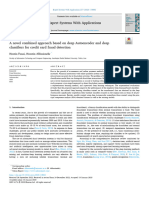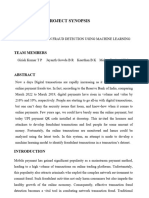0% found this document useful (0 votes)
26 views9 pagesIJCRT2505489
The document presents a novel fraud detection framework using Generative Adversarial Networks (GANs) to address the increasing fraudulent transactions in digital payment systems, particularly the Unified Payments Interface (UPI) in India. It highlights the limitations of traditional fraud detection methods and demonstrates that the GAN-based model significantly improves detection accuracy and adaptability to evolving fraud patterns. The proposed system utilizes a comprehensive set of transaction features and supports real-time monitoring, with future enhancements planned to incorporate multimodal data for better contextual awareness.
Uploaded by
pravinkumar288Copyright
© © All Rights Reserved
We take content rights seriously. If you suspect this is your content, claim it here.
Available Formats
Download as PDF, TXT or read online on Scribd
0% found this document useful (0 votes)
26 views9 pagesIJCRT2505489
The document presents a novel fraud detection framework using Generative Adversarial Networks (GANs) to address the increasing fraudulent transactions in digital payment systems, particularly the Unified Payments Interface (UPI) in India. It highlights the limitations of traditional fraud detection methods and demonstrates that the GAN-based model significantly improves detection accuracy and adaptability to evolving fraud patterns. The proposed system utilizes a comprehensive set of transaction features and supports real-time monitoring, with future enhancements planned to incorporate multimodal data for better contextual awareness.
Uploaded by
pravinkumar288Copyright
© © All Rights Reserved
We take content rights seriously. If you suspect this is your content, claim it here.
Available Formats
Download as PDF, TXT or read online on Scribd
/ 9
























































































